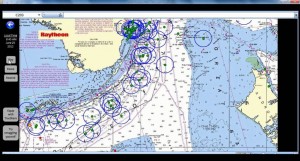“What we are doing with TracShare is developing a maritime social network.”
Dr. Tony Ponsford’s use of “social network” grabs your attention. But what Ponsford, an engineering fellow with Raytheon Canada, is trying to explain isn’t some seagoing equivalent of Facebook or Twitter, although it uses similar ideas about decentralized connectivity. Rather it is an ingenious repurposing of existing technologies to help cash- and asset-strapped governments protect their sea coasts.
Coast guards, navies and other government organizations such as the United States Department of Homeland Security face daunting challenges in protecting their coasts. There are a variety of threats – everything from drug smugglers to human traffickers to illegal fishing boats to even potentially seaborne terrorists. Further, many of the craft they need to monitor and intercept are relatively small – so-called “go-fast” boats used by drug smugglers, for example, the low-profile, high-speed fiberglass boats familiar to fans of TV’s 1980’s classic Miami Vice.
“The big problem and the big challenge,” says Ponsford, “is being able to detect small vessels and objects over a wide area that are a long way from shore.” Conventional marine radars are limited in range to line-of-sight, which is about 10 nautical miles for these small craft, so trying to track them using it requires having patrol vessels or aircraft relatively nearby a lot of the time. This sort of “persistent surveillance,” as Ponsford terms it, is expensive – prohibitively so.
The grand-prize winner of Raytheon’s Network Centric Systems 2011 Innovation Challenge, Raytheon Canada’s TracShare system combines two pre-existing technologies in a new and novel fashion.
Raytheon Canada currently markets a Marine Small Target Tracker (MSTT), which functions as an enhancer for conventional marine radar. MSTT features what might be called an interpretive function, classifying and tracking objects picked up on radar in terms of their speed, size and relative maneuverability and plotting their data onto an electronic chart. This system is used, for example, at the Straits of Gibraltar by Spain’s Guardia Civil to keep detailed tabs on ship traffic there.
TracShare will take the MSTT to sea. All sea-going vessels have radar running 24/7. And every vessel in the world over 300 tons, and all ships involved in international trade, are equipped with a system known as AIS (Automatic Information System), which periodically transmits the ship’s name, registry, type, destination, port of origin and GPS coordinates. TracShare takes the information picked up by an individual ship’s radar, after it has been enhanced via the MSTT, and then uses the host ship’s AIS transponder to relay what can be seen via its radar.
“Let’s say I’m a host vessel,” Ponsford says, “maybe a B.C. ferry. I’ve got my radar on, I’m going into the inlets of Vancouver Island, and I’m picking up information. Normally there are no other radar systems out there, and the Canadian authorities aren’t aware what’s taking place in these inlets. [With TracShare] now I’ve got my B.C. ferry in there broadcasting back to the maritime operations centre what they see.”
You start to understand the idea behind a maritime social network when you imagine numerous vessels equipped with TracShare. What they build up is a mosaic of overlapping radar plots that a land based control station can use to pick out likely vessels far offshore, and then continue to track them as they move in toward land. And the data that TracShare gathers can be shared with other similarly equipped vessels.
“Hitting a log or a floating oil barrel at sea can be a disaster,” says Ponsford. TracShare would let vessels know about potential hazards well in advance. This would be useful particularly in the future as areas such as the Northwest Passage become relatively open for transit. TracShare would give freighters and tankers transiting Arctic waters extra warning of what Ponsford describes as “bergy bits,” large chunks of ice that could potentially slow down or damage ships.
This feature, and the fact that by making use of AIS technology it doesn’t require the purchase of an additional transmitter, should help make it attractive to ship owners.
Tests of the system, using data culled from the waters off southern Florida, to see how well TracShare would do in waters rife with drug and human smugglers suggests that, were 75 percent of the ships plying the area equipped with TracShare, the coastguard could grab 95 percent of the potential threats attempting to enter American waters. And, says Ponsford, you need only make sure that 50 to 60 percent of likely vessels were so equipped to cause a major dent in illegal smuggling operations.
TracShare to date has undergone a number of tests at sea. The next stage is a major trial for the U.S. government. “It’s too early to call them a customer,” Ponsford says, “but they are definitely interested.”
Ian Coutts is a freelance writer, author of four books, and a frequent contributor to Vanguard. His writing has appeared in Toronto Life, Canadian Business, the Globe and Mail, and elsewhere.

